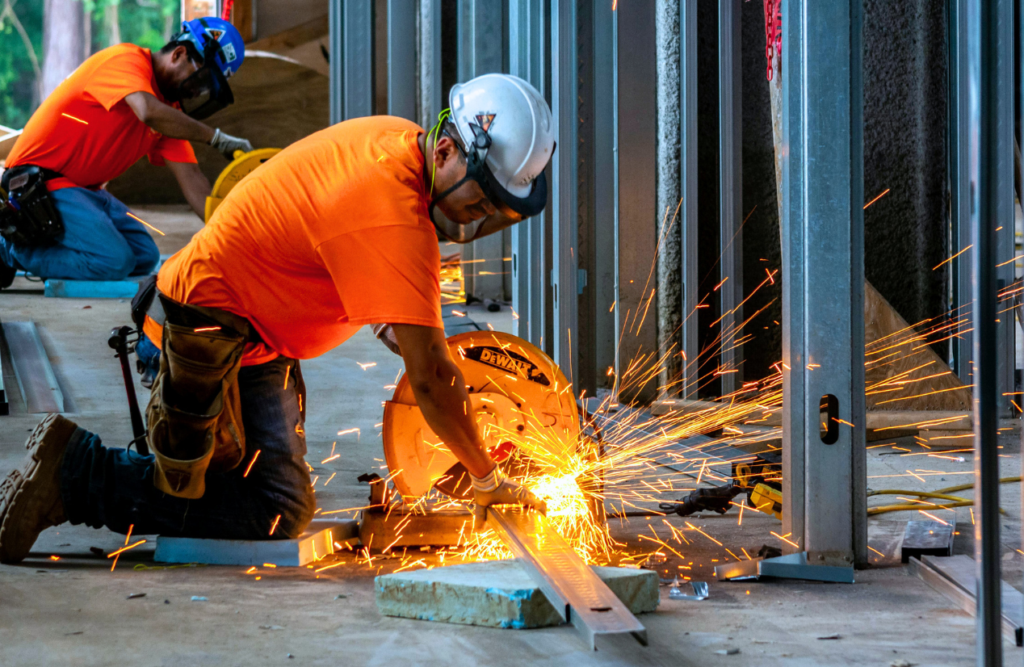Design and Construct (D&C) under a Design and Construct Contract is a widely used project delivery method in Australia, where a single contractor takes responsibility for both designing and building the project. This guide explains how a Design and Construct Contract works, its benefits and risks, and what to consider when using this model for construction works.
Key Takeaways about a Design and Construct Contract
- Design and Construction Contracts involve one contractor managing both design and build.
- They are used in residential, commercial, and infrastructure projects.
- The Contractor takes over a performance brief or concept design and delivers the full project.
- The D&C model transfers design risk to the Contractor, requiring careful documentation.
- Commonly used forms include AS4902-2000, commonly with Principal-drafted Special Conditions.
Introduction to Design and Construction Contracts
Design and Construct Contracts, also known as D&C Contracts, consolidate design and building responsibilities under a single agreement. They are used across the Australian construction industry to streamline communication, reduce disputes, and fast-track delivery. Rather than splitting responsibility between designers and builders, this contract model ensures one party takes charge of delivering a compliant, functioning building based on the principal’s performance brief.
From infrastructure developments and multi-residential buildings to commercial and public sector projects, the Design and Construct Contract is a core method of construction delivery in Australia. They offer a different risk allocation and procurement process compared to traditional construct-only contracts.

1. What Design and Construction Contracts Mean in Practice
A Design and Construction Contract places full responsibility for both the design documentation and construction on the contractor. The principal provides a performance brief, and the contractor manages all aspects of delivery.
Rather than engaging a designer separately, the principal engages a contractor who is responsible for delivering the entire project. This method is ideal for projects where timing, budget certainty, or streamlined communication is essential.
2. The Design and Construction Process
The process usually starts with the principal developing a clear brief that outlines the expected outcomes. A concept design may be included to guide the contractor. Once a D&C contractor is appointed, they complete the design phase using their consultants or novated consultants and begin construction, often while design is still being finalised.
This overlap can result in faster project delivery but requires strong project management and contract clarity. Design and Construction Contracts support this by assigning responsibilities early and explicitly.

3. Comparison with Traditional Construction Contracts
Traditional contracts separate design and construction into two phases managed by different parties. The principal hires an architect, finalises documentation, then tenders the build.
By contrast, a Design and Construct Contract assigns both responsibilities to one contractor. This limits the risk of coordination errors and reduces the risk of design-related disputes. However, it also reduces the principal’s control over the final design.
4. Why Developers and Principals Choose Design and Construction Contracts
This contract type is chosen for several strategic reasons:
- Faster timelines through overlapping phases
- Budget certainty at an earlier stage
- Clearer accountability for design defects
- Simplified project management structure
- Less administrative burden from managing separate consultants
Design and Construction Contracts are particularly valuable in time-sensitive or large-scale developments where the principal prioritises delivery over design control.

5. How Contractors Manage Design Responsibility
Contractors take on significant risk under a Design and Construct Contract. They are liable for errors in design documentation and construction quality. As a result, Contractors typically:
- Engage experienced architects and engineers
- Carry professional indemnity insurance
- Use design managers to coordinate consultants
- Review constructability early
- Document variations and changes to design scope
The commercial viability of a D&C Contract depends on how well the Contractor manages these responsibilities.
6. The Principal’s Role in a Design and Construction Project
While the Contractor carries design and delivery risk, the Principal still plays a critical role:
- Preparing a clear and detailed performance brief
- Selecting an experienced contractor
- Retaining approval rights over certain design elements
- Monitoring compliance with key milestones
A well-prepared brief is essential. Without it, the Principal may find the end product does not meet their expectations.

7. Novation of Consultants
Often, the principal will engage consultants early, such as an architect or engineer, to prepare concept plans. Under Design and Construction Contracts, these consultants are typically novated to the contractor after appointment.
This means they now work under the contractor’s direction, and the contractor becomes responsible for their work. Novation supports design continuity but must be managed carefully to avoid conflicts of interest or loss of quality.
8. Key Contract Clauses in Design and Construction Agreements
Important clauses to address in a D&C agreement include:
- Design obligations and standards
- Performance requirements
- Design warranties and indemnities
- Variations process
- Delay and liquidated damages
- Insurance requirements
- Design approvals and submissions
AS4902-2000 is the most commonly used standard form in Australia and includes these features. However, many contracts are heavily amended or bespoke. A design and construction agreement that is becoming more and more used is the Two Stage Design and Construct Contract, which mimics the Defence Early Contractor Involvement model.

9. Typical Risks in Design and Construction Contracts
Risks include:
- Incomplete or ambiguous performance briefs
- Inadequate contractor experience with design management
- Contractor-led design choices that reduce quality
- Disputes about whether design meets the brief
- Delays due to overlapping design and build
Mitigating these risks requires careful contract drafting and performance monitoring.
10. Compliance and Regulatory Obligations
Contractors delivering D&C projects must comply with all applicable legislation and standards, including:
- National Construction Code (NCC)
- State-based building acts
- Planning approvals
- Licensing requirements for design practitioners
A Design and Construct Contract does not reduce legal obligations. Instead, it centralises responsibility in the hands of the contractor.

11. How Design and Construction Contracts are Priced
Most D&C contracts use a lump sum pricing model. The contractor provides a fixed price for delivering the completed design and building. Other pricing models include:
- Guaranteed Maximum Price (GMP)
- Cost Plus
- Target Cost with shared savings
The chosen pricing model should match the project scope, design maturity, and risk appetite of the parties.
12. Early Contractor Involvement in D&C
Some D&C projects include an Early Contractor Involvement (ECI) phase. This allows the contractor to contribute to design decisions before committing to a final price.
Benefits include:
- Early resolution of constructability issues
- Value engineering opportunities
- Collaborative design development
ECI is common in large public infrastructure or complex commercial builds.

13. Legal and Statutory Framework
Statutory obligations are not avoided under D&C models. Contractors must ensure designs are compliant with:
- Building Codes and Standards
- Local government approvals
- Disability access and fire safety
- Professional indemnity and construction insurance laws
In jurisdictions like New South Wales, contractors and consultants may also need to be registered as Design Practitioners.
14. Is D&C Always the Right Choice?
Design and Construction Contracts work best when:
- The principal wants a single point of contact
- Budget and timing certainty are critical
- The design can be described through performance requirements
- The contractor is experienced in managing design and construction risk
They may not suit projects where:
- The principal wants to control detailed design
- There is no clear project brief
- The contractor lacks internal design capability
15. Summary of the Design and Construction Model
Design and Construction Contracts offer a practical way to reduce interfaces and allocate design risk to the contractor. They are best suited to projects that need speed, efficiency, and simplified delivery.
When used properly, they reduce delays, align accountability, and give contractors more flexibility to innovate. But the quality of outcomes depends on how clearly the scope is defined and how well the contract is managed.

Call us Now to Discuss Your Design and Construct Contract
We have over 25 years of experience in drafting, negotiating, reviewing, and advising on Design and Construction Contracts.

FAQs About Design and Construct Contract
1. What is a Design and Construct Contract?
A Design and Construct Contract is a construction agreement where the contractor is responsible for both the design and the build, based on the principal’s performance requirements. This model shifts design risk to the contractor and is widely used in commercial, residential, and infrastructure projects in Australia.
2. What are the benefits of using a Design and Construction Contract?
The benefits of using a Design and Construction Contract include faster delivery, streamlined communication, fewer interfaces between parties, and a single point of accountability for design errors and construction defects.
3. What are the risks of a Design and Construction Contract?
The risks of a Design and Construction Contract include reduced design control for the principal, potential quality issues, and disputes if the performance brief is not clear. These risks are managed through detailed documentation and clear communication.
4. What is novation in the context of Design and Construction Contracts?
Novation in Design and Construction Contracts is the process where consultants originally engaged by the principal are transferred to the contractor, making the contractor responsible for their work. This ensures continuity but requires careful management.
5. What type of projects use Design and Construction Contracts?
Projects that use Design and Construction Contracts include large residential developments, infrastructure projects like hospitals and schools, commercial office buildings, and industrial facilities. These contracts are particularly common where time and cost certainty are priorities.
6. How does pricing work in Design and Construction Contracts?
Pricing in Design and Construction Contracts is typically lump sum, meaning the contractor agrees to deliver the full project for a fixed price. Other pricing models may also be used depending on project complexity and contract structure.
7. What is the difference between traditional and Design and Construction Contracts?
The difference between traditional and Design and Construction Contracts lies in who holds the design responsibility. In traditional models, the principal engages the designer; in D&C, the contractor is responsible for design and construction.
8. Can you use AS4902 for Design and Construction Contracts?
AS4902 is specifically designed for Design and Construction Contracts and is the most commonly used standard form contract in Australia for D&C procurement.
9. What is D&C in Construction?
D&C in Construction refers to the Design and Construct model, where the contractor is responsible for delivering both the design and the construction of a project. This model is commonly formalised through a Design and Construction Contract.
10. What legal obligations apply under Design and Construction Contracts?
Legal obligations under Design and Construction Contracts include compliance with building codes, statutory warranties, licensing laws, and duty of care to third parties. Contractors must also ensure their consultants are appropriately registered and insured.
11. Is Early Contractor Involvement used with Design and Construction Contracts?
Early Contractor Involvement is often used with Design and Construction Contracts to allow collaboration on design before final pricing. It supports value engineering, constructability reviews, and better design outcomes before committing to a lump sum.

Relevant Articles
- Construction Law
- Construction Lawyer
- Construction Lawyer Brisbane
- Construction Lawyers Brisbane
- Construction Contract Review
- The Ultimate Guide to Construction and Contracting
- Indemnities, Insurances, and Limits of Liability in Construction Contracts
- Construction Contracts
- Construction Lawyers
- Construction Contract Management
- Construction Contract Administration
- Construction Contract Disputes
- Brisbane Construction Industry
- Construction Industry
- Construction Finance
- Negotiating Changes to a Signed Construction Contract
- Understanding Your Construction Contract
- Project Delivery Methods
- Risk Management in Construction Contracts
- Escalation Clauses
- Construct-Only Contract
- Liquidated Damages in Construction Contracts
- AS 4000-1997 Guide for Contractors
- AS 4000-1997 Guide for Principals
- Guide to AS2124-1994 – Australian Standard Conditions of Contract for Construct Only Projects
- Construction Contract Law
- Construction Contract Liquidated Damages
- Types of Construction Contracts
- Your Design and Construct Contract Explained
- Design and Construct vs Construct-Only
- Dealing with Construction and Building Materials in Your Contract
- Fixed Price Building Contract
- Latent Conditions: Dealing With a Latent Condition at a Construction Site
- DLP Meaning – What is the Defects Liability Period in Construction Contracts?
- Construction Contract Termination
- Construction Contract Templates
- Is a Cyclone a Force Majeure Event in a Construction Contract?
- Construction Contract Variations
- Teaming Agreement
- Strategies for Cost Control in Construction
- Guide to Construction Contracts in Australia
- Practical Guide to Your Building Contract
- Building Contract Law: Tips for Builders and Principals
- Security in Construction Contracts: Bank Guarantees and Retention Moneys
- Time Cost Quality: Mastering the Project Management Triangle
